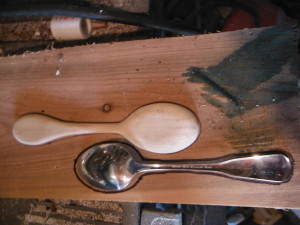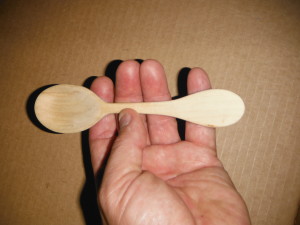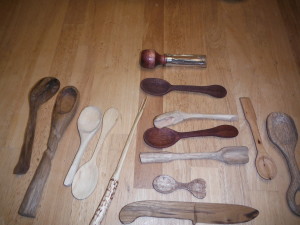Being a hillbilly, I whittle. Sometimes I’m just making shavings and sawdust, but from time to time, I make something useful. One of my favorite useful things to whittle is a wooden spoon.
I won’t say I’m a pro by any means, but I will say that you can use some of them to eat with. In fact, my daughters and wife fully believe that ice cream should only be eaten with a wooden spoon. From time to time, the ladies task me with replacing their ice cream spoons, and I gladly oblige. Yes, it seems my girls can eat enough ice cream to wear out a wooden spoon!
I tend to approach spoon carving in one of two ways, freestyle or duplication. Both methods have their pros and cons.
When I pick up a piece of wood, I usually go for the freestyle method, and typically end up with a spoon that is crooked, of center, warped, or just plain ugly. But they are very fun to make, and the creation process soothes me. There is really no good reason to rush whittling, so the slow, easy process makes for some good therapy, and a way to unwind from this worlds fast paced.
 When I’m trying to make multiple spoons to be used, I usually trace an already existing spoon over top of the wood I plan to carve. Please keep in mind that some woods are toxic, be sure to use something that is NOT toxic. I like using maple, white pine, butternut, and for this example, cedar. Cedar isn’t my first choice, since it tends to be brittle and doesn’t carve very well, but it is what I had on hand. I do this often, simply using what I have access to. For example, I have a lovely spoon I carved freehand from a piece of Australian pine I picked up while walking through my back yard. (Second from the right in the first picture).
When I’m trying to make multiple spoons to be used, I usually trace an already existing spoon over top of the wood I plan to carve. Please keep in mind that some woods are toxic, be sure to use something that is NOT toxic. I like using maple, white pine, butternut, and for this example, cedar. Cedar isn’t my first choice, since it tends to be brittle and doesn’t carve very well, but it is what I had on hand. I do this often, simply using what I have access to. For example, I have a lovely spoon I carved freehand from a piece of Australian pine I picked up while walking through my back yard. (Second from the right in the first picture).
When making several spoons for a purpose, I usually use my band saw and belt sander to rough out the spoon blank. While it IS cheating, it allows me to produce more in less time, so I am simply optimizing my time and tools. When I’m making spoons for the pleasure of it, I rarely use more than a knife and sometimes a hatchet.
I’ve used both green wood and dry wood, and don’t have a preference, each option has its benefits.
Green wood tends to be more forgiving, and most times is easier to work with. However, being green, the drying process can be tricky, and a love spoon can be ruined if not treated properly. I usually put my finished green wood spoon into a container of water to soak for several days before drying it. After a few days, I remove it, and place it in a cool, dry place out of the sun. Most times this works well, though from time to time, I lose one to cracking, splitting, or warping.
For dry wood, it has no issues once finished, at least as far as cracking, splitting, or warping. However, being dry already, it tends to want to split out more as I carve, so all work has to be done slower, and in smaller cuts. I have impatient moments occasionally, so have been known to split a spoon as I try roughing out a section. Slow and steady is the way to go with dry wood.
Whenever I lose a spoon while in the process of making it, I simply grab another piece f wood and start again. The pleasure is in the making as well as in the final product, so I’m not terribly upset if I spoil one.
 Once dried, I sometimes sand them, other time I don’t it depends on how they look and what I’m trying to accomplish. I usually rub my spoons down with olive or coconut oil, a light coating only. I then put them in a warm place, usually the top of the fridge, though sometimes in the dehydrator, in order to let the wood soak in the oil. After a day or so of warming up, I buff them again with a paper towel, then put them into use or add them to my jar of wooden spoons.
Once dried, I sometimes sand them, other time I don’t it depends on how they look and what I’m trying to accomplish. I usually rub my spoons down with olive or coconut oil, a light coating only. I then put them in a warm place, usually the top of the fridge, though sometimes in the dehydrator, in order to let the wood soak in the oil. After a day or so of warming up, I buff them again with a paper towel, then put them into use or add them to my jar of wooden spoons.
The girls know where they are, and always grab on for their ice cream.
To my girls, eating ice cream from a wooden spoon that their father made is a normal part of their lives, and a childhood memory that they’ll carry with them long after I’m gone.
I like that idea.
Peace,
db

That’s pretty cool DB.
I wonder what would happen if you oiled the greenwood spoons as they dry.
Another thought, I have read walnut oil is the preferred oil for food related wooden utensils as it does not go rancid. Of course I use mineral oil (the stool softener? ha!) because it is less expensive and more readily available at wally world.
Do you use a curved knife for the bowl part or just your regular one?
Actually, I usually use a spoon gouge to shape the bowl
read this for more details:
http://floridahillbilly.com/?p=5155